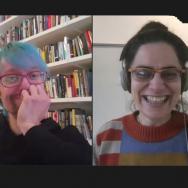Interactive media has proven itself to be one of the most powerful forces in today’s world. A group of artists, designers and technicians at the University of Chicago is pushing the boundaries of how this new media can be used to build community and shape our interactions.
This spring, a team of scholars affiliated with the Weston Game Lab and the College developed and presented A Labyrinth, an alternate reality game that utilized the UChicago campus as the playspace for a series of interactive quests. Responding to the need for community as Spring Quarter classes and activities moved online in response to COVID-19, this initiative asks big questions about the future of the arts and media.
How do we relate to each other in this new world? How do we spend time together? How can we help fill the gap left by in-person interaction—and what new ways of interaction can we devise?
Assembling a transmedia story played and built by multi-generational teams, the group behind A Labyrinth is harnessing new media’s capacity as a potent social facilitator. This innovative approach to alternate reality games (ARGs) combines online engagement with personal relationships and offers crucial opportunities to connect in a moment of social distance.
Video by Ben Kolak/Scrappers Film Group
Alternate reality games tell a story through multiple artistic and media forms, including—but not limited to—websites, video recording, live theater performance, email, social media, cryptic posters and phone calls. ARG designers integrate a puzzle into the real world and assert it as reality. Players progress through the game as themselves, and by doing so, assert the fictional world as in some sense real.
“I think it’s the most exemplary art form for a moment of ‘post-truth’ politics and transmedia network culture,” said Prof. Patrick Jagoda, co-founder of the Game Changer Chicago Design Lab and co-director of A Labyrinth. “Alternate reality games are absorptive in the sense that they combine any other art form that you can imagine.
“There are visual components, audio dimensions, interactive elements. There’s live performance and video game mechanics. You can incorporate anything from email to TikTok in terms of puzzles or participatory opportunities. ARGs have a Frankensteinian hybrid structure that offers experimental ways of exploring and intervening in our contemporary moment.”
Through this transmedia experience, players interact with the game and directly impact the course of the story through their actions and ideas. They are encouraged to solve puzzles, investigate mysteries and communicate with other players to progress through the game.
The team behind A Labyrinth is not new to the world of ARGs. The Fourcast Lab has previously developed multiple UChicago initiatives in this form for student orientations, such as the parasite and Terrarium—games that used collaborative play to disseminate information, build skills and crowdsource solutions.
In addition to Jagoda, the Fourcast Lab includes Sr. Lect. Heidi Coleman, Lect. Marc Downie, Weston Game Lab assistant director Ashlyn Sparrow, Assoc. Prof. Kristen Schilt and a team of interns.
Their work builds on the mission of the Weston Game Lab (WGL) to foster a space on campus for the research and design of groundbreaking games. Established in February 2019 as part of the Media Arts, Data, and Design (MADD) Center at the Crerar Library, the WGL—which Jagoda directs—has led directly to the blossoming of gaming-related initiatives through a variety of workshops, lectures, open houses and symposia. UChicago currently offers a minor in Media Arts and Design, but the bulk of the innovative new media work takes place through MADD Center and the WGL.
Thinking about the future of orientation games after the success of Terrarium in 2019, the team faced the unexpected challenge of a campus community that was entirely, well, off-campus.
“It was this question of, we managed to successfully engage the incoming class for orientation with Terrarium, and it was done all online,” Sparrow said. “How can we do that again for these UChicago students who essentially have been pushed off of campus? How do we make people feel connected to their community, to their campus, through the use of the game?”
A Labyrinth revolved around the story of a minotaur—a communal, inviting and shy figure who needs assistance from players to return to their home in the center of the maze. “Most of us have been disconnected physically from the University of Chicago campus, which is a kind of home,” said Jagoda. “So we wanted an allegorical narrative about helping one another come back home and about what it means to return to and rethink a home that’s been transformed.”
The team initially planned to use the interior of several buildings, including the Logan Center and the Regenstein Library, to form the architecture of the maze. When access to interior spaces became heavily restricted, the team used UChicago’s outdoor spaces and filmed hours of footage of the minotaur (known in-game as the Taur) traveling between campus buildings. With crucial assistance from Prof. Christopher Wild, Master of the Humanities Collegiate Division, they launched the game on April 6. All told, the development took less than three weeks.
“Creative work is the best way I know how to deal with helpless realities,” Coleman said. “If you act as if something is real, it becomes so.”
A Labyrinth involved 73 intergenerational and multi-location teams. In addition to UChicago students and alumni, game participants included a top-performing team of sixth-graders at the University’s Lab School and parents in the Chicago suburbs. In a time where the conventional means of establishing personal connection are increasingly strained, the digital creativity, competition and teamwork fostered through A Labyrinth offered an opportunity to build new ways of relating to each other.
The team is already looking towards the future, planning more complex stories and fine-tuning the technology. Possible projects may further blur the lines between live and recorded video, allowing players to transition seamlessly between the two. They may also target new audiences, such as middle school students.
But the goal of ARGs also extends beyond gameplay.
“We’re interested in social impact and thinking about games that feel fundamentally different from the standard educational game affair,” Sparrow said. “We’re not saying that games are the solution or the panacea for your problems, but we do think that games are a great place to think through certain problems and have people come to their own conclusions, which is why our games operate the way that they do.
“We’re not here to tell you what’s right or what’s wrong, but we do want you to be critical about how you feel or how you’re thinking about a specific problem.”
—For more information on ARGs and the making of A Labyrinth, read the full version of this story at the UChicago Arts blog.

